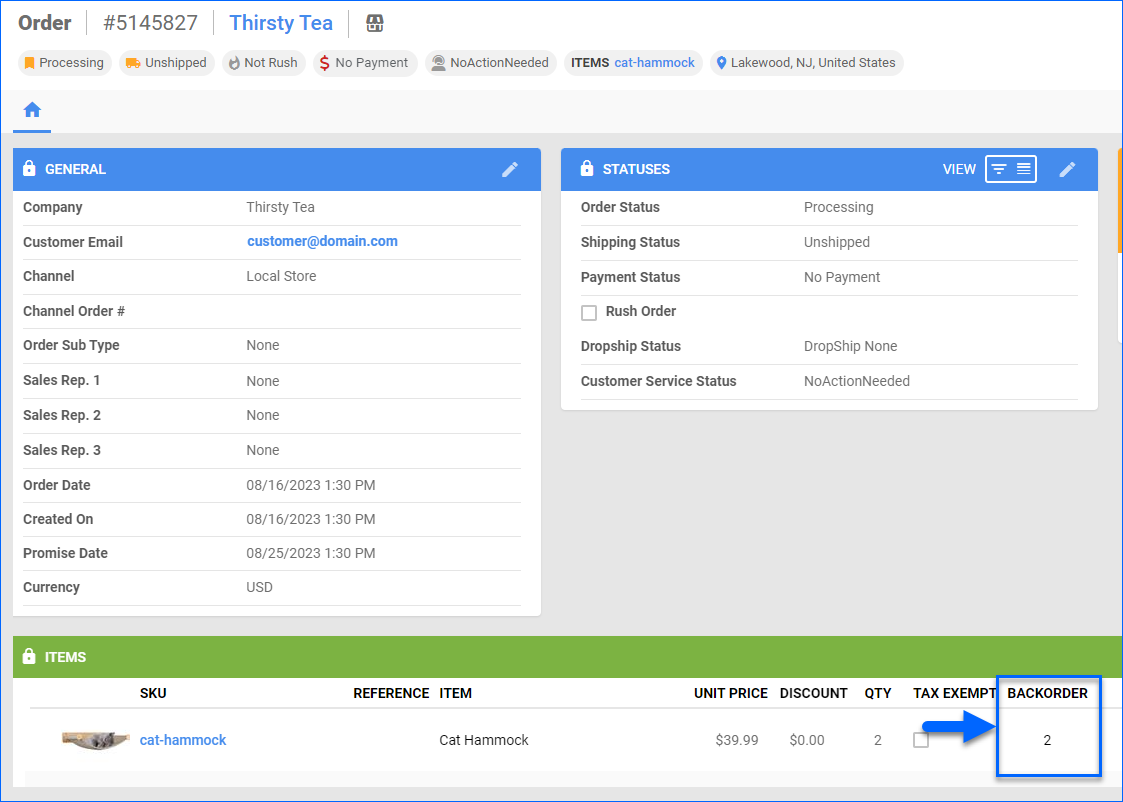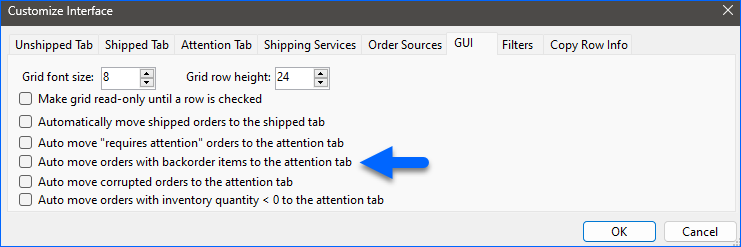Overview
Sellercloud can mark orders with a Backorder status when a customer orders an out-of-stock item. This allows you to fulfill the order at a later time once you replenish the inventory for that product.
There are several ways to handle backorders:
- Reallocate inventory
- Dropship from a vendor
- Delay the shipping or cancel the order
- Configure automated emails to notify your customers
Backorders
The Backorder quantity appears on the Order Details page’s Items panel. The backorder quantity equals the number of insufficient product units that are required to fulfill the order. When inventory becomes available, this quantity gets adjusted, and the order status gets updated accordingly.
Search Backorders
To search for backordered products:
- Go to Catalog > Manage Catalog or Inventory > Manage Inventory.
- Click Add filter and select Back Order.
- Click the Back Order filter and select the From / To backorder quantities to search for.
- Click Search.
To search your orders by backorder status:
- Go to Orders > Manage Orders.
- Click Add filter and select Back Order.
- Click the Back Order filter and select a backorder type.
- Click Search.
Manage Backorders
The following order-related actions affect your orders’ backorder status. When they occur, the backorder status and quantity are immediately updated:
- An order gets Split
- Items get added or Replaced
- Inventory becomes available through a PO Receive
When inventory becomes available, older orders get updated first. If you Manually Adjust or Set the Physical inventory of an item, you can force the recalculation of one or more backorders instead of reallocating inventory or waiting for the BackOrderReCalculateService to rerun.
Update Backorders
To update one or more orders:
- Go to Orders > Manage Orders
- Select orders by checking the boxes on the left.
- Click the blue Actions icon in the bottom right corner.
- Search for Backorder and select from these actions:
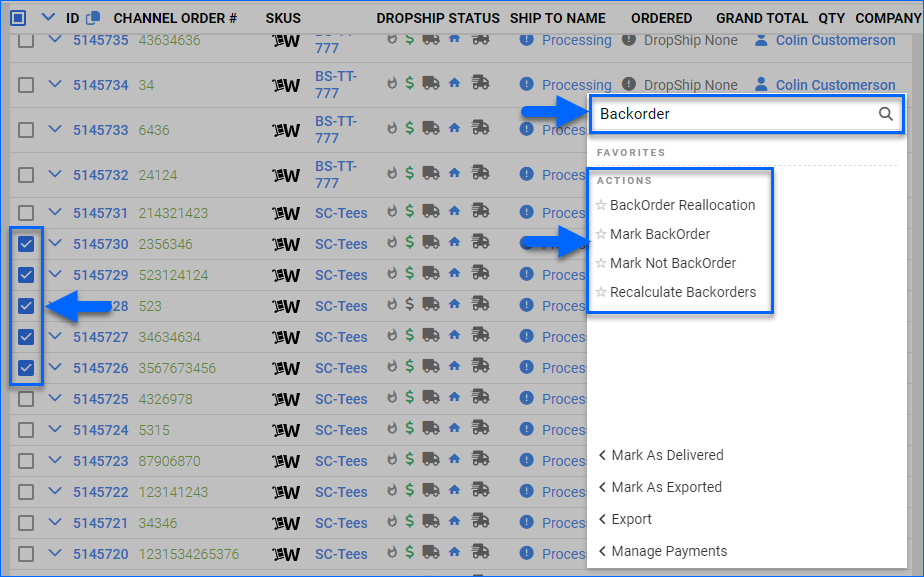
- BackOrder Reallocation – Edit the backorder quantity. This is useful when you want to reallocate an order’s backordered item to fill the backorder quantity on another order and ship it immediately. Note that your changes will be overwritten when the BackOrderReCalculateService re-runs based on the quantity available and the backorder-related Client Settings.
- Mark BackOrder – Mark orders as backorders.
- Mark Not BackOrder – Unmark orders as backorders.
- Recalculate Backorders – Recalculate the selected backorders immediately based on the currently available product quantities.
- BackOrder Reallocation – Edit the backorder quantity. This is useful when you want to reallocate an order’s backordered item to fill the backorder quantity on another order and ship it immediately. Note that your changes will be overwritten when the BackOrderReCalculateService re-runs based on the quantity available and the backorder-related Client Settings.
You can also manage backorder reallocation action for a specific order:
- Go to the Order Details Page.
- Click Toolbox and select Manage Backorder.
- On this page, you can see the quantity on order, the currently available inventory, and the backorder quantity. Click Edit, then update the Backorder Qty field and click Save.
Workflow Automation
Sellercloud also allows you to automate parts of your backorder workflow:
- Create a Saved Search with the Back Order filter.

- Create a new rule with the Order Rule Engine with a condition where the Condition Type is Order Saved View, then select the saved search created in Step 1.
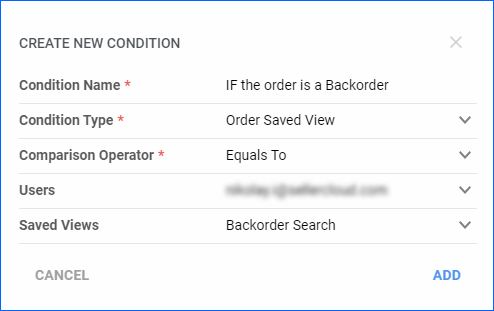
- Add Actions to apply to your backorders automatically.
Email Customers
You can automate the backorder workflow further by notifying customers about cancellations or shipping delays. You do this by creating an email template and configuring it to be sent automatically whenever a backorder occurs.
- Go to Company Settings.
- Click Toolbox and select Email Settings > Email Templates.
- Click Add New Template.
- Create a customized template to be used when an item is out of stock. You can personalize your template with Placeholders.
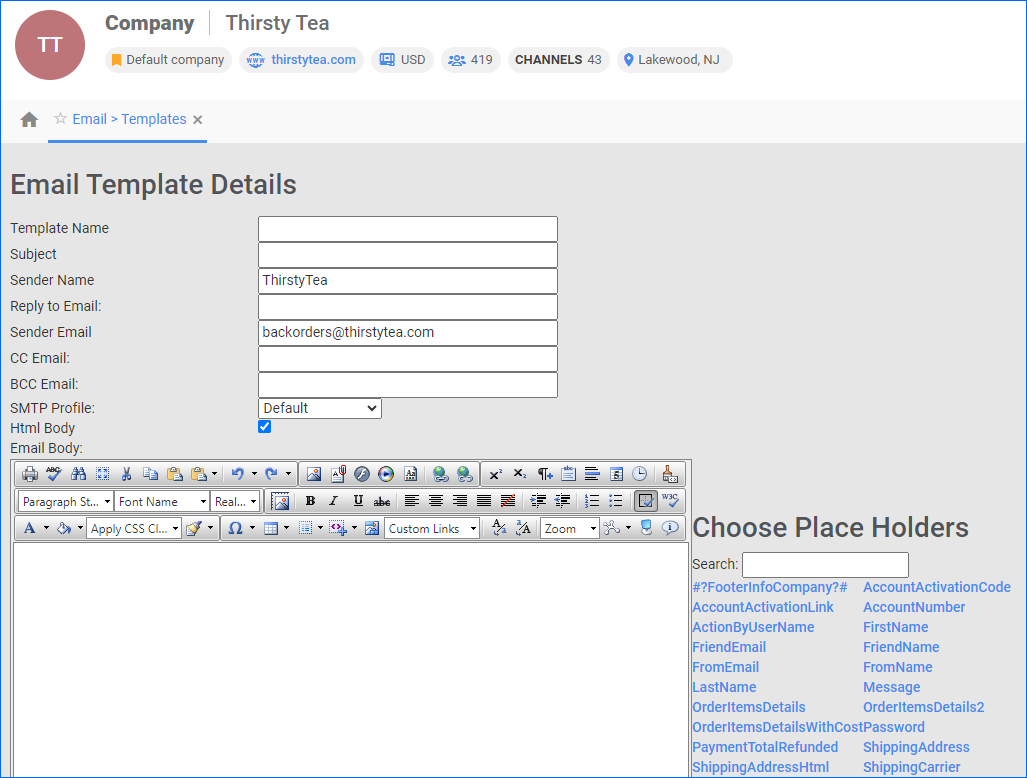
- Click Save Template.
- Click Toolbox and select Email Settings > Email Template Assignment. Here, you can select email templates to send automatically in specific scenarios.
- Click Edit.
- Scroll down to EmailCustomerForBackOrder and choose your email template.
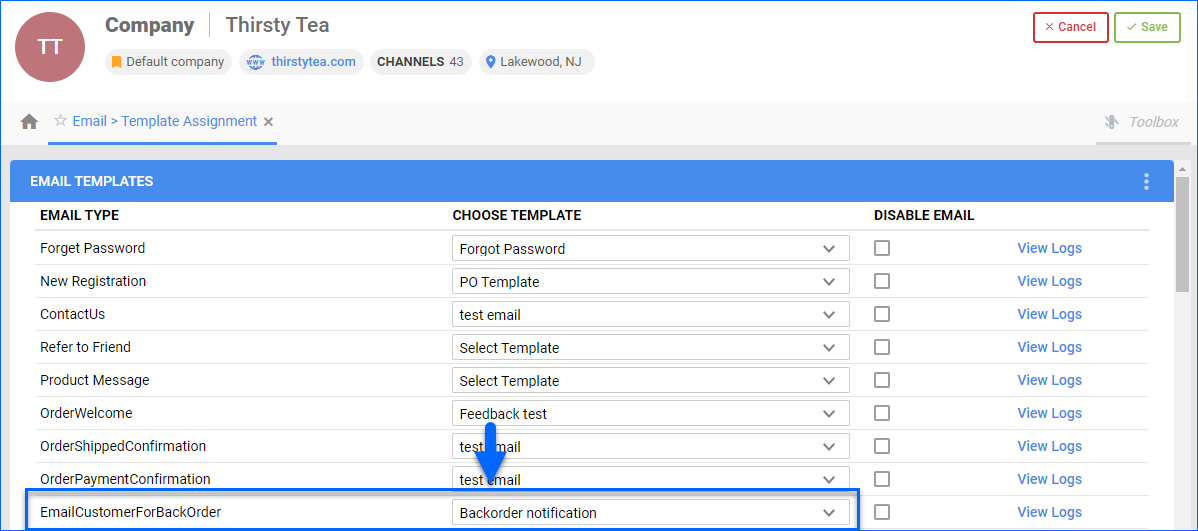
- Click Save. This email will be sent whenever an order is marked as a Backorder.
Configure Shipbridge
Shipbridge also has settings related to backorders.
You can move all backorders to Shipbridge’s Requires Attention tab instead of the Unshipped tab. To enable this option:
- Go to Menu > Customize Interface.
- Select GUI.
- Check Auto move orders with backorder items to the attention tab.
You can hide all backorders from Shipbridge’s Scan and Ship tab when entering or scanning those orders, so you will not try to ship a backorder when you have no item(s) available in the warehouse. To enable this option:
- Go to Menu > Options.
- Select the Scan and Ship tab.
- Click Ignore backorder/requires attention orders.
Shipbridge also has a filter for backorders called Back Order Status.
Client Settings
Below are the Client Settings that affect Sellercloud’s backorder calculation and general functionality.
General Settings
- Enable BackOrder Workflow – Enables all backorder functionality.
- BackOrder: Max Days to bo Back – Enable to set a specific past number of days to include in the backorder calculation. If an order is older, it will not have its backorder status changed.
- Update BackOrder status on Order Status Change – Disabled by default. Enable to automatically recalculate the backorder status based on the currently available inventory anytime an order’s status is changed from any status to On Hold or Quote or vice versa.
- Hide BackOrder Column In Manage Orders – Enable to hide the Backorder Qty column on the Manage Orders Page.
- Enable per OrderItem based BackOrder in PickList – Controls how the Mark Backorder action on the Picklist Details page works. If this setting is enabled, it will mark the items as backorder even if they have enough inventory. This setting is available only in Alpha.
- Stop Marking Orders as BackOrder while Creating Orders – Enable to prevent orders’ backorder status from being set upon creation. The backorder status will still be updated once the BackOrderReCalculateService runs.
- Do Not Send BackOrder Tags To Magento – Enable to prevent Sellercloud from sending the <backorders> and <use_config_backorders> tags to Magento.
Calculation Settings
- Use Payment Date Instead of Order Creation in Backorder Calculation – Enable to use the Payment Date instead of the Order Date when allocating product inventory for backorders during calculation.
- Use Warehouse-Based BackOrder Calculation – Enable to calculate backorder per product, based on the Ship From warehouse set on the order. This will not do the calculation for FBA, Interim, or Untested Warehouses.
- Don’t consider Dropship WH Qty as Available Qty for BackOrder calculation – Enabled by default. Excludes product quantities in Dropship Warehouses from the backorder calculation. You can use this when importing inventory from a vendor into a dropship-type warehouse, and you don’t want this inventory to be considered available.
- Don’t consider Unsellable WH Qty as Available Qty in Backorder Calculation – Enabled by default. Excludes product quantities in Unsellable Warehouses from the backorder calculation.
- Consider ReplacementSKU Qty in BackOrder Calculation – Disabled by default. If an item is out of stock, but its Replacement SKU has stock, the order will not be marked as a backorder.
- Include Authorized Orders In BackOrder Calculation – Enable to include orders with their Payment Status set to Authorized in the backorder calculation.
- Include OnHold Orders In BackOrder Calculation – Enable to include orders with their Order Status set to On Hold in the backorder calculation.
- Include Unpaid and Partially Paid Orders In BackOrder Calculation – Enabled by default. Orders with a Payment Status of Unpaid and Partially Paid will be included in the backorder calculation.
- Prioritize Fully-Shippable Orders in BackOrder Calculation – Enable to prioritize the allocation of available quantity to the order with the minimum required quantity that can be fulfilled when recalculating backorder quantities. This setting is useful when dealing with multiple backorders with different quantities. For example, if an order for 40 items with 10 on hand, and a second order for 10 comes in later, this setting will allocate quantity to the second order instead of reserving it for the first. As usual, it will try to do this for the oldest orders first.
- Prioritize Rush Orders in Backorder Calculation – Enable to prioritize the allocation of available quantities to Rush Orders when recalculating backorder quantities.
- Prioritize Picked Orders in Backorder Calculation – Enable to allocate available quantities to picked orders when recalculating backorder quantities.
Understanding backorders
The Backorder feature is only available if the BackOrderReCalculateService is running on your server; please contact Sellercloud Support to confirm that this service is installed. In addition, Enable BackOrder Workflow must be selected in Client Settings to use this feature. Read how to configure Backorder-related later in this topic. Sellercloud can mark an order with a BackOrder status when a customer orders an item for which you have no availability. When this happens, the backordered quantity will appear in the Order Details’ BackOrderQty column and the order is marked as BackOrder in the Order Status bar. When inventory does become available, the BackOrder Qty is adjusted and the Order Status is updated accordingly. Note that inventory is applied chronologically to orders, with quantity first becoming available to older orders. If you manually change the inventory of an item, you can easily force the recalculation of one or more Backorders instead of reallocating inventory or waiting for the BackOrderReCalculateService to rerun: On the Manage Orders page > Select orders > Action Menu > Recalculate Backorders > Go. This topic explains several ways to help you effectively manage your Backorders, including:
- Order-related functions affecting backorders
- Reallocating backorder quantity
- Configuring ShipBridge for backorders
- Related options for managing backorders
Finding backorders
- Open Manage Orders > Advanced Search > BackOrder dropdown field > choose Full BackOrder, Partial BackOrder, or Full or Partial BackOrder > Search.

- Open a Backorder from the Manage Orders page of results:


Order-related functions affecting backorders
The following order-related actions will have an impact on an order’s Backorder status. When any of these occur, the Backorder status and quantity is immediately determined on related orders, and other quantity adjustments will update the Backorder status periodically, throughout the day:
- An order is split
- An order has items added to it
- Inventory becomes available though a PO Receive
Reallocating backorder quantities
To be able to ship an order immediately, there may be times when you want to reallocate an order’s backordered item to fill the backorder quantity on another order. If so, you can edit the orders’ Backorder quantities and change their Backorder statuses. Here’s how:
- On the Manage Orders page— select the Backorder > Action Menu > Mark BackOrder or Mark Not BackOrder > Go.
- There are 2 places to edit an order’s Backorder quantity:
- On the Order Details page— click Action Menu > Manage Backorder Reallocation > Go; or
- On the Manage Orders page > select the Backorder > Action Menu > Manage Backorder Reallocation > Go.
- On the BackOrder Reallocation page > revise the Backorder Qty field > Update.

Your changes will be overwritten when the BackOrderReCalculateService re-runs, based on quantity available and Backorder-related Client Settings.
Configuring ShipBridge for backorders
ShipBridge has 2 convenient settings that help control Backorders:
- Menu > Customize Interface > GUI > Auto move orders with backorder items to the attention tab— This moves all Backorders to ShipBridge’s Requires Attention tab instead of the Unshipped tab, so they are easily discernible as orders that are not ready to ship.
- Menu > Options > Scan and Ship > Ignore backorder/requires attention orders— This hides all Backorders from ShipBridge’s Scan and Ship tab when entering or scanning those orders, so you will not try to ship a Backorder when you have no item(s) available in the warehouse.
Configuring Client Settings for backorders
There are a number of Client Settings that affect Sellercloud’s calculation and appearance of Backorders:
| CLIENT SETTINGS | DESCRIPTION |
| Enable BackOrder Workflow (required) |
*Enabling this will deselect the setting Hide BackOrder Column in Manage Orders. It is assumed you want to see the BackOrder icon on the Manage Orders page; however, you can override this behavior by selecting it. |
| Hide BackOrder Column in Manage Orders | Hides the BackOrder icon on the expanded Manage Orders grid and the BackOrderQty column on the Order Details page. *Selecting Enable BackOrder Workflow automatically deselects this setting |
| Stop Marking Orders as BackOrder while Creating Orders (enabled by default) |
|
| Consider ReplacementSKU Qty in BackOrder Calculation | If an item is out of stock, but its replacement SKU has stock, the order will not be marked as a backorder |
| Don’t consider Dropship WH Qty as Available Qty for BackOrder calculation (enabled by default) |
|
| Include Authorized Orders In BackOrder Calculation (enabled by default) | Orders with a Payment Status of Authorized are considered for calculating Backorders |
| Include Unpaid and Partially Paid Orders In BackOrder Calculation (enabled by default) | Orders with a Payment Status of Unpaid and Partially Paid are considered for calculating Backorders |
| Use WarehouseBased Backorder Calculation | Calculates Backorder per product, based on the Ship To warehouse set on the order. Note:This will not do the calculation for FBA, Interim, or Untested warehouse types. |
| Update BackOrder status on Order Status Change (enabled by default) | Whenever the Order Status is changed to any value, the Backorder quantity is automatically recalculated |
| Use Payment Date Instead of Order Creation in Backorder Calculation | Payment Date, not Order Date, will be used in Backorder calculations; meaning, paid Backorders will have priority over Backorders without payment |
| Prioritize FullyShippable Orders in Backorder Calculation |
|
| Include OnHold Orders In BackOrder Calculation | Orders with an Order Status of OnHold will be included in Backorder calculations |
| Enable per OrderItem Based BackOrder in PickList |
Related options for managing backorders
When an order comes in for an out-of-stock item, Sellercloud offers several other options for dealing with Backorders:
- Delaying shipping
- Dropshipping from vendor
- Cancelling order
- Emailing customers— This feature lets you email a customer about a cancellation or shipping delay. You create an email template and configure emails to be automatically sent whenever a Backorder occurs:
- Settings > choose Email Templates. (You can also go to Company Settings > Toolbox > Email Settings > Email Templates.)
- Click Add New Template and create a customized template to be used when an item is out of stock > Save Template.
- Company Settings > Toolbox > Email Settings > click Email Template Assignment. Here, you assign a specific email to send when encountering a given property.
- Scroll down to EmailCustomerForBackOrder and choose your email template > Update Grid. This email will be sent whenever an order is marked as a BackOrder.
